EMBRYOPSIDA Pirani & Prado
Gametophyte dominant, independent, multicellular, initially ±globular, not motile, branched; showing gravitropism; glycolate oxidase +, glycolate metabolism in leaf peroxisomes [glyoxysomes], acquisition of phenylalanine lysase* [PAL], flavonoid synthesis*, microbial terpene synthase-like genes +, triterpenoids produced by CYP716 enzymes, CYP73 and phenylpropanoid metabolism [development of phenolic network], xyloglucans in primary cell wall, side chains charged; plant poikilohydrous [protoplasm dessication tolerant], ectohydrous [free water outside plant physiologically important]; thalloid, leafy, with single-celled apical meristem, tissues little differentiated, rhizoids +, unicellular; chloroplasts several per cell, pyrenoids 0; centrioles/centrosomes in vegetative cells 0, microtubules with γ-tubulin along their lengths [?here], interphase microtubules form hoop-like system; metaphase spindle anastral, predictive preprophase band + [with microtubules and F-actin; where new cell wall will form], phragmoplast + [cell wall deposition centrifugal, from around the anaphase spindle], plasmodesmata +; antheridia and archegonia +, jacketed*, surficial; blepharoplast +, centrioles develop de novo, bicentriole pair coaxial, separate at midpoint, centrioles rotate, associated with basal bodies of cilia, multilayered structure + [4 layers: L1, L4, tubules; L2, L3, short vertical lamellae] (0), spline + [tubules from L1 encircling spermatid], basal body 200-250 nm long, associated with amorphous electron-dense material, microtubules in basal end lacking symmetry, stellate array of filaments in transition zone extended, axonemal cap 0 [microtubules disorganized at apex of cilium]; male gametes [spermatozoids] with a left-handed coil, cilia 2, lateral, asymmetrical; oogamy; sporophyte +*, multicellular, growth 3-dimensional*, cuticle +*, plane of first cell division transverse [with respect to long axis of archegonium/embryo sac], sporangium and upper part of seta developing from epibasal cell [towards the archegonial neck, exoscopic], with at least transient apical cell [?level], initially surrounded by and dependent on gametophyte, placental transfer cells +, in both sporophyte and gametophyte, wall ingrowths develop early; suspensor/foot +, cells at foot tip somewhat haustorial; sporangium +, single, terminal, dehiscence longitudinal; meiosis sporic, monoplastidic, MTOC [= MicroTubule Organizing Centre] associated with plastid, sporocytes 4-lobed, cytokinesis simultaneous, preceding nuclear division, quadripolar microtubule system +; wall development both centripetal and centrifugal, 1000 spores/sporangium, sporopollenin in the spore wall* laid down in association with trilamellar layers [white-line centred lamellae; tripartite lamellae]; plastid transmission maternal; nuclear genome [1C] <1.4 pg, main telomere sequence motif TTTAGGG, KNOX1 and KNOX2 [duplication] and LEAFY genes present, ethylene involved in cell elongation; chloroplast genome with close association between trnLUAA and trnFGAA genes [precursors for starch synthesis], tufA, minD, minE genes moved to nucleus; mitochondrial trnS(gcu) and trnN(guu) genes +.
Many of the bolded characters in the characterization above are apomorphies of more or less inclusive clades of streptophytes along the lineage leading to the embryophytes, not apomorphies of crown-group embryophytes per se.
All groups below are crown groups, nearly all are extant. Characters mentioned are those of the immediate common ancestor of the group, [] contains explanatory material, () features common in clade, exact status unclear.
POLYSPORANGIOPHYTA†
Sporophyte well developed, branched, branching dichotomous, potentially indeterminate; hydroids +; stomata on stem; sporangia several, terminal; spore walls not multilamellate [?here].
II. TRACHEOPHYTA / VASCULAR PLANTS
Sporophyte long lived, cells polyplastidic, photosynthetic red light response, stomata open in response to blue light; plant homoiohydrous [water content of protoplasm relatively stable]; control of leaf hydration passive; plant endohydrous [physiologically important free water inside plant]; PIN[auxin efflux facilitators]-mediated polar auxin transport; (condensed or nonhydrolyzable tannins/proanthocyanidins +); borate cross-linked rhamnogalactan II, xyloglucans with side chains uncharged [?level], in secondary walls of vascular and mechanical tissue; lignins +; roots +, often ≤1 mm across, root hairs and root cap +; stem apex multicellular [several apical initials, no tunica], with cytohistochemical zonation, plasmodesmata formation based on cell lineage; vascular development acropetal, tracheids +, in both protoxylem and metaxylem, G- and S-types; sieve cells + [nucleus degenerating]; endodermis +; stomata numerous, involved in gas exchange; leaves +, vascularized, spirally arranged, blades with mean venation density ca 1.8 mm/mm2 [to 5 mm/mm2], all epidermal cells with chloroplasts; sporangia in strobili, sporangia adaxial, columella 0; tapetum glandular; sporophyte-gametophyte junction lacking dead gametophytic cells, mucilage, ?position of transfer cells; MTOCs not associated with plastids, basal body 350-550 nm long, stellate array in transition region initially joining microtubule triplets; archegonia embedded/sunken [only neck protruding]; embryo suspensor +, shoot apex developing away from micropyle/archegonial neck [from hypobasal cell, endoscopic], root lateral with respect to the longitudinal axis of the embryo [plant homorhizic].
[MONILOPHYTA + LIGNOPHYTA]Sporophyte growth ± monopodial, branching spiral; roots endomycorrhizal [with Glomeromycota], lateral roots +, endogenous; G-type tracheids +, with scalariform-bordered pits; leaves with apical/marginal growth, venation development basipetal, growth determinate; sporangium dehiscence by a single longitudinal slit; cells polyplastidic, MTOCs diffuse, perinuclear, migratory; blepharoplasts +, paired, with electron-dense material, centrioles on periphery, male gametes multiciliate; nuclear genome [1C] 7.6-10 pg [mode]; chloroplast long single copy ca 30kb inversion [from psbM to ycf2]; mitochondrion with loss of 4 genes, absence of numerous group II introns; LITTLE ZIPPER proteins.
LIGNOPHYTA†
Sporophyte woody; stem branching axillary, buds exogenous; lateral root origin from the pericycle; cork cambium + [producing cork abaxially], vascular cambium bifacial [producing phloem abaxially and xylem adaxially].
SEED PLANTS† / SPERMATOPHYTA†
Growth of plant bipolar [plumule/stem and radicle/root independent, roots positively geotropic]; plants heterosporous; megasporangium surrounded by cupule [i.e. = unitegmic ovule, cupule = integument]; pollen lands on ovule; megaspore germination endosporic, female gametophyte initially retained on the plant, free-nuclear/syncytial to start with, walls then coming to surround the individual nuclei, process proceeding centripetally.
EXTANT SEED PLANTS
Plant evergreen; nicotinic acid metabolised to trigonelline, (cyanogenesis via tyrosine pathway); microbial terpene synthase-like genes 0; primary cell walls rich in xyloglucans and/or glucomannans, 25-30% pectin [Type I walls]; lignin chains started by monolignol dimerization [resinols common], particularly with guaiacyl and p-hydroxyphenyl [G + H] units [sinapyl units uncommon, no Maüle reaction]; roots often ≥1 mm across, stele diarch to pentarch, xylem and phloem originating on alternating radii, cork cambium deep seated, gravitropism response fast; stem apical meristem complex [with quiescent centre, etc.], plasmodesma density in SAM 1.6-6.2[mean]/μm2 [interface-specific plasmodesmatal network]; eustele +, protoxylem endarch, endodermis 0; wood homoxylous, tracheids and rays alone, tracheid/tracheid pits circular, bordered; mature sieve tube/cell lacking functioning nucleus, sieve tube plastids with starch grains; phloem fibres +; cork cambium superficial; leaf nodes 1:1, a single trace leaving the vascular sympodium; leaf vascular bundles amphicribral; guard cells the only epidermal cells with chloroplasts, stomatal pore with active opening in response to leaf hydration, control by abscisic acid, metabolic regulation of water use efficiency, etc.; branching by axillary buds, exogenous; prophylls two, lateral; leaves with petiole and lamina, development basipetal, lamina simple; sporangia borne on sporophylls; spores not dormant; microsporophylls aggregated in indeterminate cones/strobili; grains monosulcate, aperture in ana- position [distal], primexine + [involved in exine pattern formation with deposition of sporopollenin from tapetum there], exine and intine homogeneous, exine alveolar/honeycomb; ovules with parietal tissue [= crassinucellate], megaspore tetrad linear, functional megaspore single, chalazal, sporopollenin 0; gametophyte ± wholly dependent on sporophyte, development initially endosporic [apical cell 0, rhizoids 0, etc.]; male gametophyte with tube developing from distal end of grain, male gametes two, developing after pollination, with cell walls; embryo cellular ab initio, suspensor short-minute, embryonic axis straight [shoot and root at opposite ends], primary root/radicle produces taproot [= allorhizic], cotyledons 2; embryo ± dormant; chloroplast ycf2 gene in inverted repeat, trans splicing of five mitochondrial group II introns, rpl6 gene absent; ??whole nuclear genome duplication [ζ/zeta duplication event], 2C genome size (0.71-)1.99(-5.49) pg, two copies of LEAFY gene, PHY gene duplications [three - [BP [A/N + C/O]] - copies], 5.8S and 5S rDNA in separate clusters.
IID. ANGIOSPERMAE / MAGNOLIOPHYTA
Lignans, O-methyl flavonols, dihydroflavonols, triterpenoid oleanane, apigenin and/or luteolin scattered, [cyanogenesis in ANA grade?], lignin also with syringyl units common [G + S lignin, positive Maüle reaction - syringyl:guaiacyl ratio more than 2-2.5:1], hemicelluloses as xyloglucans; root cap meristem closed (open); pith relatively inconspicuous, lateral roots initiated immediately to the side of [when diarch] or opposite xylem poles; epidermis probably originating from inner layer of root cap, trichoblasts [differentiated root hair-forming cells] 0, hypodermis suberised and with Casparian strip [= exodermis]; shoot apex with tunica-corpus construction, tunica 2-layered; starch grains simple; primary cell wall mostly with pectic polysaccharides, poor in mannans; tracheid:tracheid [end wall] plates with scalariform pitting, multiseriate rays +, wood parenchyma +; sieve tubes enucleate, sieve plates with pores (0.1-)0.5-10< µm across, cytoplasm with P-proteins, not occluding pores of plate, companion cell and sieve tube from same mother cell; ?phloem loading/sugar transport; nodes 1:?; dark reversal Pfr → Pr; protoplasm dessication tolerant [plant poikilohydric]; stomata randomly oriented, brachyparacytic [ends of subsidiary cells ± level with ends of guard cells], outer stomatal ledges producing vestibule, reduction in stomatal conductance with increasing CO2 concentration; lamina formed from the primordial leaf apex, margins toothed, development of venation acropetal, overall growth ± diffuse, secondary veins pinnate, fine venation hierarchical-reticulate, (1.7-)4.1(-5.7) mm/mm2, vein endings free; flowers perfect, pedicellate, ± haplomorphic, protogynous; parts free, numbers variable, development centripetal; P = T, petal-like, each with a single trace, outer members not sharply differentiated from the others, not enclosing the floral bud; A many, filament not sharply distinguished from anther, stout, broad, with a single trace, anther introrse, tetrasporangiate, sporangia in two groups of two [dithecal], each theca dehiscing longitudinally by a common slit, ± embedded in the filament, walls with at least outer secondary parietal cells dividing, endothecium +, cells elongated at right angles to long axis of anther; tapetal cells binucleate; microspore mother cells in a block, microsporogenesis successive, walls developing by centripetal furrowing; pollen subspherical, tectum continuous or microperforate, ektexine columellate, endexine restricted to the apertural regions, thin, compact, intine in apertural areas thick, orbicules +, pollenkitt +; nectary 0; carpels present, superior, free, several, spiral, ascidiate [postgenital occlusion by secretion], stylulus at most short [shorter than ovary], hollow, cavity not lined by distinct epidermal layer, stigma ± decurrent, carinal, dry; suprastylar extragynoecial compitum +; ovules few [?1]/carpel, marginal, anatropous, bitegmic, micropyle endostomal, outer integument 2-3 cells across, often largely subdermal in origin, inner integument 2-3 cells across, often dermal in origin, parietal tissue 1-3 cells across, nucellar cap?; megasporocyte single, hypodermal, functional megaspore lacking cuticle; female gametophyte lacking chlorophyll, four-celled [one module, egg and polar nuclei sisters]; ovule not increasing in size between pollination and fertilization; pollen grains bicellular at dispersal, germinating in less than 3 hours, siphonogamy, pollen tube unbranched, growing towards the ovule, between cells, growth rate (ca 10-)80-20,000 µm h-1, tube apex of pectins, wall with callose, lumen with callose plugs, penetration of ovules via micropyle [porogamous], whole process takes ca 18 hours, distance to first ovule 1.1-2.1 mm; male gametophytes tricellular, gametes 2, lacking cell walls, ciliae 0, double fertilization +, ovules aborting unless fertilized; fruit indehiscent, P deciduous; mature seed much larger than fertilized ovule, small [<5 mm long], dry [no sarcotesta], exotestal; endosperm +, ?diploid [one polar nucleus + male gamete], cellular, development heteropolar [first division oblique, micropylar end initially with a single large cell, divisions uniseriate, chalazal cell smaller, divisions in several planes], copious, oily and/or proteinaceous, embryo short [<¼ length of seed]; plastid and mitochondrial transmission maternal; Arabidopsis-type telomeres [(TTTAGGG)n]; nuclear genome [2C] (0.57-)1.45(-3.71) [1 pg = 109 base pairs], ??whole nuclear genome duplication [ε/epsilon event]; ndhB gene 21 codons enlarged at the 5' end, single copy of LEAFY and RPB2 gene, knox genes extensively duplicated [A1-A4], AP1/FUL gene, palaeo AP3 and PI genes [paralogous B-class genes] +, with "DEAER" motif, SEP3/LOFSEP and three copies of the PHY gene, [PHYB [PHYA + PHYC]]; chloroplast IR expansions, chlB, -L, -N, trnP-GGG genes 0.
[NYMPHAEALES [AUSTROBAILEYALES [MONOCOTS [[CHLORANTHALES + MAGNOLIIDS] [CERATOPHYLLALES + EUDICOTS]]]]]: wood fibres +; axial parenchyma diffuse or diffuse-in-aggregates; pollen monosulcate [anasulcate], tectum reticulate-perforate [here?]; ?genome duplication; "DEAER" motif in AP3 and PI genes lost, gaps in these genes.
[AUSTROBAILEYALES [MONOCOTS [[CHLORANTHALES + MAGNOLIIDS] [CERATOPHYLLALES + EUDICOTS]]]]: phloem loading passive, via symplast, plasmodesmata numerous; vessel elements with scalariform perforation plates in primary xylem; essential oils in specialized cells [lamina and P ± pellucid-punctate]; tension wood + [reaction wood: with gelatinous fibres, G-fibres, on adaxial side of branch/stem junction]; anther wall with outer secondary parietal cell layer dividing; tectum reticulate; nucellar cap + [character lost where in eudicots?]; 12BP [4 amino acids] deletion in P1 gene.
[MONOCOTS [[CHLORANTHALES + MAGNOLIIDS] [CERATOPHYLLALES + EUDICOTS]]] / MESANGIOSPERMAE: benzylisoquinoline alkaloids +; sesquiterpene synthase subfamily a [TPS-a] [?level], polyacetate derived anthraquinones + [?level]; outer epidermal walls of root elongation zone with cellulose fibrils oriented transverse to root axis; P more or less whorled, 3-merous [?here]; pollen tube growth intra-gynoecial; extragynoecial compitum 0; carpels plicate [?here]; embryo sac monosporic [spore chalazal], 8-celled, bipolar [Polygonum type], antipodal cells persisting; endosperm triploid.
[CERATOPHYLLALES + EUDICOTS]: ethereal oils 0 [or next node up]; fruit dry [very labile].
EUDICOTS: (Myricetin +), asarone 0 [unknown in some groups, + in some asterids]; root epidermis derived from root cap [?Buxaceae, etc.]; (vessel elements with simple perforation plates in primary xylem); nodes 3:3; stomata anomocytic; flowers (dimerous), cyclic; protandry common; K/outer P members with three traces, ("C" +, with a single trace); A ?, filaments fairly slender, anthers basifixed; microsporogenesis simultaneous, pollen tricolpate, apertures in pairs at six points of the young tetrad [Fischer's rule], cleavage centripetal, wall with endexine; G with complete postgenital fusion, stylulus/style solid [?here], short [<2 x length of ovary]; seed coat?; palaeotetraploidy event.
[PROTEALES [TROCHODENDRALES [BUXALES + CORE EUDICOTS]]]: (axial/receptacular nectary +).
[TROCHODENDRALES [BUXALES + CORE EUDICOTS]]: benzylisoquinoline alkaloids 0; euAP3 + TM6 genes [duplication of paleoAP3 gene: B class], mitochondrial rps2 gene lost.
[BUXALES + CORE EUDICOTS]: mitochondrial rps11 gene lost.
CORE EUDICOTS / GUNNERIDAE: (ellagic and gallic acids +); leaf margins serrate; compitum + [one position]; micropyle?; γ genome duplication [allopolyploidy, 4x x 2x], x = 3 x 7 = 21, 2C genome size (0.79-)1.05(-1.41) pg, PI-dB motif +; small deletion in the 18S ribosomal DNA common.
[ROSIDS ET AL. + ASTERIDS ET AL.] / PENTAPETALAE / [SANTALALES, CARYOPHYLLALES, SAXIFRAGALES, DILLENIALES, VITALES, ROSIDAE, [BERBERIDOPSIDALES + ASTERIDAE]: root apical meristem closed; (cyanogenesis also via [iso]leucine, valine and phenylalanine pathways); flowers rather stereotyped: 5-merous, parts whorled; P = K + C, K enclosing the flower in bud, with three or more traces, odd K adaxial, C with single trace; A = 2x K/C, in two whorls, alternating, (many, but then usually fasciculate and/or centrifugal); pollen tricolporate; G [(3, 4) 5], when 5 opposite K, whorled, placentation axile, style +, stigma not decurrent, compitum + [one position]; endosperm nuclear/coenocytic; fruit dry, dehiscent, loculicidal [when a capsule]; floral nectaries with CRABSCLAW expression, RNase-based gametophytic incompatibility system present.
Phylogeny. Prior to the seventh version of this site asterids were part of a major polytomy that included rosids, Berberidopsidales, Santalales, and Caryophyllales, but then the order of branching below the asterids seemed to be stabilizing, perhaps with a clade [Berberidopsidales [Santalales [Caryophyllales + Asterids]]] while rosid relationships seemed to be [Saxifragales [Vitales + Rosids]]]. However, recent work suggests a polytomy is indeed probably the best way to visualize relationships around here at present. So for further discussion of relationships at the base of asterids and rosids, see the Pentapetalae
[SAXIFRAGALES + ROSIDS] / ROSANAE Takhtajan / SUPERROSIDAE: ??
ROSIDS / ROSIDAE: anthers ± dorsifixed, transition to filament narrow, connective thin.
[ROSID I + ROSID II]: (mucilage cells with thickened inner periclinal walls and distinct cytoplasm); if nectary +, usu. receptacular; embryo long; chloroplast infA gene defunct, mitochondrial coxII.i3 intron 0.
ROSID II / MALVIDAE / [[GERANIALES + MYRTALES] [CROSSOSOMATALES [PICRAMNIALES [SAPINDALES [HUERTEALES [MALVALES + BRASSICALES]]]]]]: ?
[CROSSOSOMATALES [PICRAMNIALES [SAPINDALES [HUERTEALES [MALVALES + BRASSICALES]]]]]: ?
Age. Suggestions for the age of this node are (91-)85(-77) Ma (N. Zhang et al. 2012) and about 105/112 or 112.9 Ma (Tank et al. 2015: Table S1, S2 and Magallón et al. 2015 respectively); other estimates for stem Crossosomatales, i.e. this node, are 89-83 Ma (Anderson et al. 2005), ca 106.7 Ma, Magallón and Castillo (2009), (108-)104, 97(-93) Ma, Wikström et al. (2001), two estimates of (112-)105(-98) and (88-)81(-74)Ma by Hengchang Wang et al. (2009), (119-)108, 106(-99)Ma by Bell et al. (2010) and ca 99.7Ma by Naumann et al. (2013). Check the topologies in all cases!
Evolution: Divergence & Distribution. The character "compound leaves" could be placed at this node; however, wherever it goes it is very homoplasious.
Phylogeny. See the Pentapetalae page for further discussions on the relationships of Crossosomatales.
CROSSOSOMATALES Reveal - Main Tree.
?Nodes; leaves or leaflets involute, margins toothed; inflorescence terminal; hypanthium +, with nectary; G stipitate, postgenital connation +, styluli +, compitum present only near stigma, stigma ± expanded, wet; ovules apotropous, micropyle bistomal [zig-zag], outer integument 4 or more cells across, inner integument 4 or more cells across, nucellar cap +, obturator 0, hypostase +; antipodal cells degenerate; seed testal, walls of outer cell layers much thickened; endosperm +. - 7 families, 12 genera, 66 species.
Includes Aphloiaceae, Crossosomataceae, Geissolomataceae, Guamatelaceae, Stachyuraceae, Staphyleaceae, Strasburgeriaceae.
Note: In all node characterizations, boldface denotes a possible apomorphy, (....) denotes a feature the exact status of which in the clade is uncertain, [....] includes explanatory material; other text lists features found pretty much throughout the clade. However, the precise node to which many characters, particularly the more cryptic ones, should be assigned is unclear. This is partly because homoplasy is very common, in addition, basic information for all too many characters is very incomplete, frequently coming from taxa well embedded in the clade of interest and so making the position of any putative apomorphy uncertain. Then there are the not-so-trivial issues of how character states are delimited and ancestral states are reconstructed (see above).
Age. Wikström et al. (2001) dated the beginning of diversification here to (99-)95, 91(-87) Ma The age of crown group Crossosomatales was also variously estimated as (94-)88(-82) and (57-)51(-45) Ma, Bayesian relaxed clock estimates being up to 100 Ma, by Hengchang Wang et al. (2009), and also (110-)92, 84(-61) Ma (Bell et al. 2010) and about 84.6 Ma (Magallón et al. 2015).
Evolution: Divergence & Distribution. Oh (2009, 2010) discussed the complex biogeography of the group; there is a Northern/Southern Hemisphere split within it, i.e. the first four families versus the second three families; both vicariance and long distance dispersal seem to be involved (see also Christenhusz & Chase 2013).
Matthews and Endress (2005a, 2006b for a summary) emphasised a number of distinctive features of the order, even if exactly where some of these are to be placed on the tree is unclear. For instance, the funicular vascular bundle ends undivided in the chalaza in Stachyuraceae and some Staphyleaceae, whereas it splits into 3-6 short bundles in the other families (Geissolomataceae were not studied). Is a divided bundle an apomorphy for the order (or larger group), lost in the Staphlyeaceae-Crossosomataceae clade, and so a synapomorphy for it, but then regained in Crossosomataceae itself? Or is its distribution to be explained by some other combination of gains and losses (the distribution of "luminous" stylar canals and loculi may be similar)? Matthews and Endress (2005a, 2006b) also note that there is much more in common between members of Crossosomatales in the broad sense (as delimited below) than between Crossosomataceae, Stachyuraceae, and Staphyleaceae included in some narrow circumscriptions of the order.
Chemistry, Morphology, etc.. For a survey of wood anatomy, with a listing of the features - possibly plesiomorphic - common to the whole order, see Carlquist (2007c). For the distribution of characters of floral morphology in the group, I largely follow the excellent study by Matthews and Endress (2005a), which should be consulted for more details, alternative interpretations of states, etc. The inner integument in particular may be only three cells thick (Crossosoma, Geissoloma).
Phylogeny. Crossosomatales are a surprising group, but they are likely to be monophyletic. Details of some of the relationships in the tree below like [[Aphloiaceae + Ixerbaceae] [Staphyleaceae [Stachyuraceae + Crossosomataceae]]] (D. Soltis et al. 1999, 2000; c.f. in part Koontz and Soltis 1999) and [Geissolomataceae [Staphyleaceae [Stachyuraceae + Crossosomataceae]]] (rbcL tree in Nandi et al. 1998) have been suggested; see also Savolainen et al. (2000a). The tree is based on these studies, and in particular those of Sosa and Chase (2003), Oh and Potter (2006), Soltis et al. (2007a) and Oh (2009: Aphloiaceae not included). Crossosomatales as a whole are usually not very strongly supported, although they have 1.0 p.p. in Soltis et al. (2007a). The distinctive Guamatela has been added to Crossosomatales (Oh & Potter 2006: three genes); it had strong support as sister to [Stachyuraceae + Crossosomataceae], and these relationships are followed here for the time being (see also M. Sun et al. 2016), although the position of Stachyuraceae was not stable in the analyses of Oh (2009, but see Oh 2010). H.-T. Li et al. (2021: plastome data) recovered the relationships [Staphyleaceae [Stachyuraceae [Guametalaceae + Crossosomataceae]]]. On the other hand, Baker et al. (2021: Seed Plant Tree, Angiosperms353 nuclear genes), Zuntini et al. (2024: Suppl. Fig. 4) and others have found the relationships [Guamatelaceae [Staphyleaceae [Crossosomataceae + Stachyuraceae]]] in this part of the tree.
In an analysis of mitochondrial genes, Qiu et al. (2010) found that Zygophyllales were embedded in Crossosomatales, but with only moderate support (sister to Aphloia! - long branch attraction?); the combined clade was poorly supported. Does Gumillea (ex-Cunoniaceae) belong here? It has no characters suggesting a particular position anywhere...
Classification. This is a remarkably heterogeneous group, as Oh and Potter (2006) mentioned as they rather reluctantly decided to place Guamatela in a monotypic family.
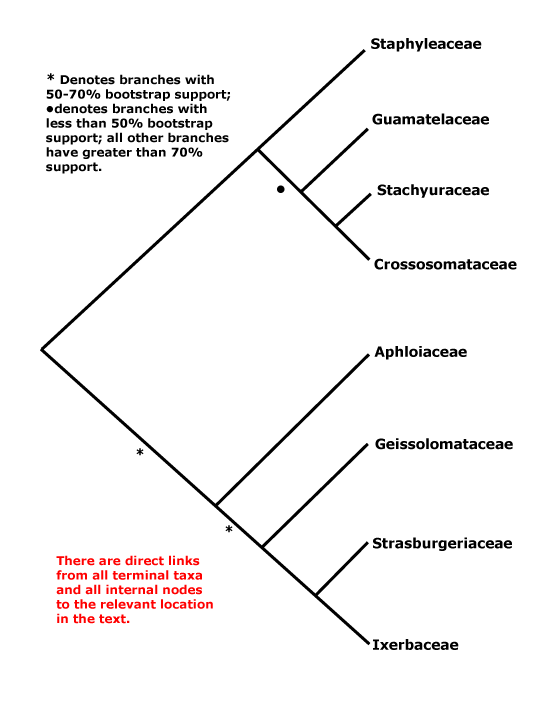
Synonymy: Crossosomatinae Reveal, Geissolomatinae Reveal - Geissolomatales Reveal, Staphyleales Martius - Crossosomatanae Doweld
[Staphyleaceae [Guamatelaceae [Stachyuraceae + Crossosomataceae]]]: ?
Age. The age of Crossosomatales, crown group, at 47-40 Ma, properly refers to this clade (Anderson et al. 2005). Other estimated ages for this node include (68-)62, 56(-50) Ma (Wikström et al. 2001), ca 76.3 Ma (Magallón & Castillo 2009), (48-)37, 34(-14) Ma (Bell et al. 2010), as much as ca 106.8 Ma (Tank et al. 2015: Table S1 - older than stem age of Crossosomatales - ca 49.5 Ma: Table S2) and as little as around 31.3 Ma (Magallón et al. 2015), or ca 63.5 Ma (Vetters et al. 2025).
Chemistry, Morphology, etc.. For a summary of embryological characters, see Ishida and Tokuoka (2017: no Guamatelaceae).
STAPHYLEACEAE Martynov, nom. cons. —— Synonymy: Ochranthaceae A. Jussieu - Back to Crossosomatales
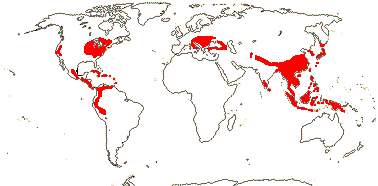
Evergreen to deciduous shrubs to trees; ellagic acid 0; wood often fluorescing; fibres with bordered pits; nodes 3:3, 5:5; petiole bundles (interrupted) annular; mucilage cells +; stomata anisocytic; cuticle waxes as (parallel) platelets; leaves opposite, odd-pinnately compound (uni-, trifoliolate), "glands" or stipels at articulations, stipules interpetiolar or not; K ± petal-like, A = and opposite K, filaments flattened, anthers sagittate, tapetal cells 2-nucleate; pollen microreticulate; nectary vascularized; G connate, [2-3(-4)], odd member adaxial; (1-)6-12 ovules/carpel, (basal), orientation variable, (micropyle endostomal), outer integument 4-6 cells across, inner integument 3-4 cells across, parietal tissue 2-8 cells across, nucellar cap 2-3 cells across/(0); (megaspore mothers cells 3); fruit a berry/dry and inflated/follicular, K persistent or not; seeds few, hilum well developed, with 3-several scars of vascular strands in a horseshoe shape (not); testa multiplicative, vascularized, 12-16 cells across, exotesta palisade/spongy [Euscaphis], mesotesta thick-walled, lignified, endotesta slightly thick-walled, unlignified, tegmen multiplicative, 5-14 cells across, crushed; embryo (chlorophyllous), cotyledons large; n = (11-)13(-15), x = 13, nuclear genome [1 C] (0.025-)0.808(-25.929)[?] pg.
2[?] [list]/45: Staphylea (23), Dalrympelea (20-25). North temperate, tropics in America (to Bolivia) and Malesia. Map: see van der Linden (1960), Meusel et al. (1978) and Tiffney (1979). [Photo - Fruit, Staphylea Flower, Fruits.]
Crwown-group Staphyleaceae are perhaps around 33.4 Ma (Vetters et al. 2025).
Fruits of Staphylea - the seeds were missing - have been described from the Oligocene of Montana (H. Zhu & Manchester 2020).Evolution: Divergence & Distribution. Turpinia has an extensive fossil record in the northern hemisphere from the Eocene onwards (Tiffney 1979 for a review); for fossils of Staphylea, which are Oligocene or younger, see Y.-J. Huang et al. (2015); see also Vetters et al. (2025) for fossils here.
Chemistry, Morphology, etc.. Dickison (1987b) noted the distinctive nodal anatomy of the family, with small accessory traces from the central bundle going to the leaves. The pollen is binucleate according to Kimoto and Tokuoka (1999).
See Simmons (2006: general), Hegnauer (1973, 1990: chemistry), Lobreau-Callen (1977: pollen), Carlquist and Hoekman (1985: wood anatomy), Dickison (1986a: floral morphology, 1987a: pollen morphology, 1987b: vegetative anatomy), Ramp (1987: gynoecium), Ishida and Tokuoka (2017: embryology), Guérin (1901) and Riddle (1905), ovules, and Guérin (1901), Tiffney (1979), and Danilova (1996), all seed structure.
Phylogeny. Simmons and Panero (2000: abstract) thought that genera in Staphyleaceae were polyphyletic. Other work suggests that relationships in the family are [Euscaphis [Staphylea + Turpinia]] (Wen et al. in Huang et al. 2015). Harris et al. (2017a) found that six chloroplast markers gave the relationships [Euscaphis [Old World Staphylea [Asian-North American Staphylea + Turpinia]]] and with moderate to strong support, GBSSI the relationships [Asian-North American Staphylea [Old World Turpinia [Old World Staphylea [New World Turpinia + Euscaphis]]]], support varying from good to poor, while with ITS Euscaphis was sister to the rest of the family, and although the major groupings were the same, the topology differed yet again, but without support. In early unpublished analyses, Simmons (2002) found some support for the relationships [Euscaphis, New World Turpinia/Staphylea = Staphylea/T. cochinchinensis + Old World Turpinia = Dalrympelea].
Taxonomy. The limits of the genera accepted until recently, based on fruit morphology, are certainly unsatisfactory (Simmons & Panero 2000; Harris et al. 2017a); Simmons (2006) realigned the genera, but this was perhaps premature.
Previous Relationships. Staphyleaceae were placed in Sapindales by Cronquist (1981) and Takhtajan (1997). Tapiscia and Huertea have long been recognised as being rather different from other Staphyleaceae, i.a. having spirally-arranged leaves (see Dickison 1987 for a convenient table of differences). Molecular data suggest that they are not at all closely related, and here they are included in Huerteales.
[Guamatelaceae [Stachyuraceae + Crossosomataceae]]: funicular aril +.
Age. The age of this node is about 26 Ma (Magallón et al. 2015).
GUAMATELACEAE S. Oh & D. Potter - Guamatela tuerckheimii Donnell Smith - Back to Crossosomatales
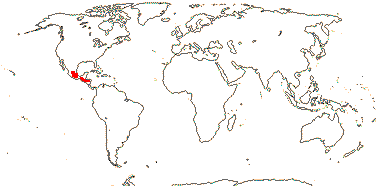
Sprawling evergreen shrub; chemistry?; nodes 3:3; petiole bundles annular; stomata ?; leaves opposite, lamina ?vernation, venation palmate, lower surface tomentose; ?inflorescence; K coloured, C spathulate; A 10, anthers sagittate; pollen membranes protruding through apertures, surface microreticulate; G 3; ovules many/carpel, biseriate; fruit a follicle, K persistent; seeds many; endosperm scanty; n/x = ?
1 [list]/1. Mexico, Guatemala, and Honduras. Map: approximate only.
Chemistry, Morphology, etc.. Anatomy, embryology, and chemistry are largely unknown.
Previous Relationships. Guamatela used to be included in Rosaceae (Oh & Potter 2002; Potter 2003), and it does indeed look faintly Rubus-like.
[Stachyuraceae + Crossosomataceae]: crystals/druses absent from flowers; anthers X-shaped; megaspore mother cells 2<; whole testa sclerotic.
Age. Stachyuraceae and Crossosomataceae may have diverged (40-)26, 24(-12) Ma (Bell et al. 2010), ca 44 Ma (Tank et al. 2015: Table S2), (49-)44, 42(-37) Ma (Wikström et al. 2001), 68.3±10.4 Ma (Zhu et al. 2006), (90.6-)54.3(-21.9) Ma (J.-X. Su et al. 2020), ca 40 Ma (Vetters et al. (2025)) or as little as 23.4 Ma (Magallón et al. 2015).
STACHYURACEAE J. Agardh, nom. cons. - Stachyurus Siebold & Zuccarini - Back to Crossosomatales
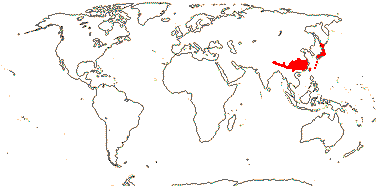
Shrubs or small trees, evergreen or deciduous; ellagic acid +; true tracheids +; pith conspicuous; petiole bundle(s) arcuate; hairs eglandular, (cuticle waxes as tubes); stomata paracytic; leaves spiral; inflorescences long-racemose, axillary; flowers 4-merous, hypanthium 0; K decussate; A = 2 x K, tapetal cells 2(-1)-nucleate; pollen grains (tricellular), smooth; nectary at base of G; G [4], opposite K, placentation intrusive apical-parietal, style +, compitum +, stigma capitate-peltate; ovules many/carpel, biseriate, parietal tissue 3-8 cells across; obturator ?+; fruit a berry, K deciduous; seeds many, aril ?+, soft; tegmen obliterated; embryo moderate, cotyledons large; n = (11) 12, x = 12, nuclear genome [1C] (0.025-)0.808(-25.929)[?] pg.
1/7 [list]. Himalayas to southern China, Formosa to Japan. Map: from Li (1943), Chen (1981) and J.-X. Su et al. (2020). [Photo - Habit/Fruits, Inflorescence]
Age. Crown-group Stachyuraceae may be (20.4-)6.8(-0.4) Ma (J.-X. Su et al. 2020).
Evolution: Divergence & Distribution. Stachyurus may have a phylgenetic fuse of close to 50 ma (see J.-X. Su et al. 2020).
Chemistry, Morphology, etc.. The leaves have veins running to opaque, deciduous teeth. The stomata are reported as being anomocytic (Beauvisage 1920; Schneider 2006).
Although the flowers appear to be perfect, Schneider (2006) suggested that cryptic dioecy may be the norm. For pollen, see Jin and Wei (2002); they described the surface as being foveate and the grains as being 18-28µm in size, larger than those of Tapiscia (see Tapisciaceae, Huerteales) but smaller than the finely reticulate grains of Staphyleaceae (28-40µm). The micropyle is zig-zag and there is a massive nucellus. The seeds are described as having a soft aril (Shan 1999; J.-X. Su et al. 2020).
Details of the flower are taken from Hooker (1882) and of embryology from Mauritzon (1936b), Mathew and Chaphekar (1977) and Kimoto and Tokuoka (1999); see Beauvisage (1920) for some anatomy, Hegnauer (1973, 1990) for chemistry, Chen (1981) and Su et al. (2020) for species, Schneider (2006) for general information.
Phylogeny. Y.-P. Zhu et al. (2006) and J.-X. Su et al. (2020) provide phylogenies for the genus; Stachyurus praecox, from Japan and Taiwan, is sister to the rest of the genus, which is from China.
Previous Relationships. Stachyuraceae were included in Theales by Takhtajan (1997).
CROSSOSOMATACEAE Engler, nom. cons. - Back to Crossosomatales
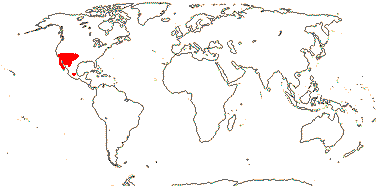
Shrubs, (deciduous), (spiny); inulin, ellagic acid +; vessel elements with simple perforation plates; nodes also 3:1; yellow acicular crystals common; leaves spiral or opposite, "small", (margins entire), stipules minute, petiolar or 0; (plant polygamo-monoecious); flowers often axillary, solitary; flowers (3-)4-5(-6)-merous, (nectary 0); A 4-many, opposite sepals or from 10 trunk bundles; tapetal cells polyploid/several nucleate; pollen microreticulate; G 1-5(-9), odd member adaxial, styluli short, stigma also decurrent; ovules (1-)2-many/carpel, pleurotropous, amphi- or campylotropous, outer integument ca 7 cells across, inner integument ca 4 cells across, parietal tissue 4-7(?<) cells across, (nucellar cap 0); antipodal cells multiplicative, but ephemeral; fruit a follicle; seed with fimbriate aril; endotegmen fibrous; embryo curved; n = 6, x = 12.
4 [list]/7: Crossosoma (3). W. North America. Map: from Hannon (2002) and Allen and Ayers (2021: Fig. 5). [Photo - Crossosoma Collection.]
Chemistry, Morphology, etc.. The vessel elements in the primary xylem of Crossosoma have scalariform perforation plates (Carlquist 2018b).
Velascoa has a long hypanthial tube, but it apparently lacks a nectary.
Information is taken from Hegnauer (1964, 1989: chemistry), P. E. Richardson (1968: general), Mauritzon (1939a) and Kapil (1970), both embryology, etc., DeBuhr (1978: wood anatomy), Tatsuno and Scogin (1978: chemistry), Thorne and Scogin (1978: inclusion of Forsellesia), Rzedowski and Rzedowski (1997: new genus), Hannon (2002: review), and Sosa (2006: general summary).
Phylogeny. For relationships within the family, see Sosa and Chase (2003); Crossosoma may be sister to the rest. Allen and Ayers (2021, see also references) suggest that the relationships here are [[Apacheria + Glossopetalum] [Crossosoma + Velascoa]].
Previous Relationships. Crossosomataceae were included in Rosales by Cronquist (1981) and were sister taxon to Geraniaceae in some early molecular studies (e.g. Price & Palmer 1993); Takhtajan (1997) included a monofamilial Crossosomatales in his Rosidae.
[Aphloiaceae [Geissolomataceae + Strasburgeriaceae]]: conspicuous protrusions from pollen apertures ["pollen buds"].
Age. The age of this node is around (101-)82, 75(-53) Ma (Bell et al. 2010), (86-)81(-76) Ma (Wikström et al. 2001), about 69.7 Ma (Magallón et al. 2015) or about 93.9 Ma (Tank et al. 2015: Table S1, S2).
APHLOIACEAE Takhtajan - Aphloia theiformis (Vahl) Bennett - Back to Crossosomatales
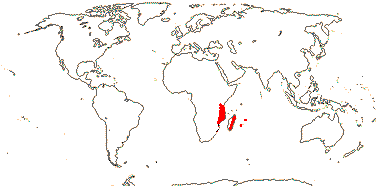
Evergreen shrubs or trees; cork pericyclic; tracheids dimorphic; rays of two different widths; vasicentric or apotracheal parenchyma; petiole bundles arcuate; stomata anisocytic; plant glabrous; leaves two-ranked; inflorescence fasciculate, axillary; P +, ?spiral, ca 7; A many; pollen striate; G 1, style 0, stigma annular-peltate-bilobed; ovules ca 10/carpel, micropyle endostomal; fruit a berry, P and A persistent; testa with outer 3-5 cell layers much thickened, then small unthickened cells, then 2-3 layers of elongated unthickened cells; endosperm development?; embryo curved, terete; x = 7/6 (?12).
1 [list]/1 or more. E. Africa, Madagascar, the Mascarenes and Seychelles. Map: from Trop. Afr. Fl. Pl. Ecol. Distr. vol. 1 (2003). [Photo - Fruit]
Evolution: Divergence & Distribution. Oh (2010) suggested that there is considerable sequence variation in Aphloia; detailed study of the variation patterns within the genus are needed, and there is probably more than a single species.
Chemistry, Morphology, etc.. The hypanthial region is broad and spreading and its surface may be nectariferous. The ovules are possibly campylotropous and are not simply anatropous.
Details of the seed coat are in part taken from Takhtajan (1992), for wood anatomy, see Miller (1975), while Hegnauer (1989, as Flacourtiaceae) gives a few details of plant chemistry; see Kubitzki (2006b) for a summary.
Previous Relationships. Aphloia used to be included in Flacourtiaceae, although it is different anatomically (Miller 1975); it was included as a separate family in Violales by Takhtajan (1997).
[Geissolomataceae + Strasburgeriaceae]: hairs single-celled, lignified and ± T-shaped; pollen ± smooth; G synascidiate, not stipitate, alternate with P/K, abaxially ridged, style long, towards tips twisted, postgenitally united at apex, stigma punctiform; ovules two/carpel, collateral, pendant; fruit a capsule, terminated by persistent style; hilum on seed large.
Age. This clade is about 51.6 Ma (Magallón et al. 2015).
Evolution: Divergence & Distribution. Matthews and Endress (2006b) emphasize the synapomorphies of this clade.
GEISSOLOMATACEAE A.-L. de Candolle, nom. cons. Geissoloma marginatum (L.) de Jussieu - Back to Crossosomatales
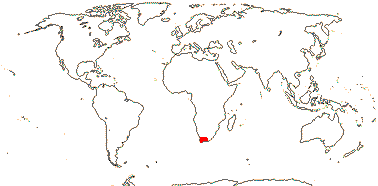
Evergreen shrubs; plants Al-accumulators; cork cambium outer cortical; nodes 1:1; leaves opposite, lamina margins entire, apex mucronate, secondary veins palmate, paired projections [?stipules] on petioles; flowers single, axillary, with 3-4 pairs of basal bracts; flower 4-merous; P +, uniseriate, 4, petal-like, basally connate; A adnate to base of P, obdiplostemonous; G [4], alternate with P; ovules apotropous, micropyle exostomal, hypostase +; fruit a loculicidal capsule, surrounded by persistent K; seed with funicular caruncle; coat with thick-walled cells; endosperm development?, embryo ?small, cotyledons thin; n/x = ?
1/1 [list]. Cape Floristic Province, South Africa (map: from Heywood 1978).
Chemistry, Morphology, etc.. For information on nodal anatomy, R. A. Howard (pers. comm.); general information is taken from Baillon (1875), Dahlgren in Dahlgren and van Wyk (1988, "micropyle endostomal", but c.f. Stephens 1909a and Forest 2006); leaf anatomy from Carlquist (1990a), seed coat from Danilova (1996).
Previous Relationships. Geissolomataceae were included in Celastrales by Cronquist (1981), in Ericanae by Takhtajan (1997).
STRASBURGERIACEAE van Tieghem, nom. cons. - Back to Crossosomatales
Evergreen trees; vessel elements long, with scalariform [>27 bars] perforation plates; cells with thickened mucilaginous inner tangential walls; acicular crystals +; leaves spiral, lamina margins gland-toothed; flowers large; K spiral, C clawed; filaments flattened, anthers ³3mm long; style hollow; ovules sessile, ?epitropous; x = 25
2/2 [list]. New Caledonia and New Zealand.
Age. Crown-group Strasburgeriaceae are about 23.5 Ma (Magallón et al. 2015).
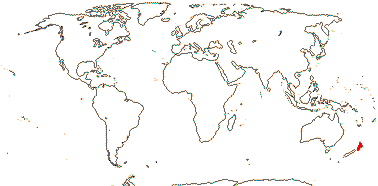
1. Ixerba brexioides A. Cunningham —— Synonymy: Ixerbaceae Doweld & Reveal
Non-hydrolysable tannins 0; cork?; petiole bundles arcuate; stipules 0; inflorescence umbellate, terminal; A = and opposite K; pollen 4-5-colporate; nectary on G, obscurely lobed, lobes opposite petals; G [5], style strongly ridged and obviously spiral at apex; parietal tissue ca 8 cells across, chalazal tissue massive funicular obturator +; fruit loculicidal, carpels also splitting adaxially, valves woody, reflexed, K deciduous; seeds shiny, "aril" broad, exotestal and adjacent cells thickened; endosperm development?, embryo chlorophyllous, cotyledons large; n = 25.
1/1. North Island, New Zealand.
2. Strasburgeria calliantha (Pancher & Sebert) Guillaumin
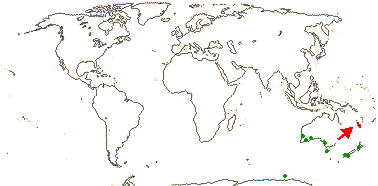
Chemistry?; stem with cortical bundles [= lateral foliar bundles]; nodes also 5:5; petiole bundles ± C-shaped, arcuate; calcium oxalate as ± spheroidal masses [epiderms/hypodermis]; cuticle waxes almost thread-like scales; lamina teeth with a single vein and opaque deciduous cap, stipules intrapetiolar, connate basally; flowers single, axillary; hypanthium 0; K 8-10, spiral, C 5 (6); A 10, in a single whorl, obdiplostemonous, anthers latrorse, connective thick, anther thecae attached their length to connective; base of ovary surrounded by erect flange with ten short "spokes" cupping filament bases; G [4-7], adnate to central column, stigmas lobed; ovule 1/carpel, outer integument 7-8 cells across, parietal tissue 8-10 cells across; fruit indehiscent, rather dry, K persistent; outer testa of 5-12 layers of crystalliferous sclereids; endosperm +, moderate; n = 250.
1/1. New Caledonia, on ultrabasic rocks (map: fossil localities green, from Jarzen & Pocknall 1993). [Photo - Flower]
Evolution: Divergence & Distribution. Caenozoic pollen like that of extant Strasburgeria, although rather smaller, has been found from Australia, Tasmania, and New Zealand (see Blufopollis scabratus: Jarzen & Pocknall 1993; Lee et al. 2001), and also off Wilkes Land, Antarctica, in deposits of Early Eocene age ca 51.9 Ma (Pross et al. 2012; Contreras et al. 2103). This suggests that the genus was once quite widely distributed in the Antipodean-Antarctic area - but the age of the fossils is rather greater than molecular estimates of the family crown-group age.
Chemistry, Morphology, etc.. In Ixerba glands like those of lamina margin are in a cauline stipular position in seedlings. Strasburgeria, at least, has a mucilaginous epidermis, and in both genera mucilaginous cells are found in the flower.
The vascular supply to the carpel walls in Strasburgeria is complex (Dickison 1981a, q.v. for much other information). The exact function of the complex ?nectariferous flange+spoke structure at the base of the ovary is unclear.
Details of anatomy of Ixerba are taken from Gregory (1998: in Escalloniaceae) and Hils (1985) while Hegnauer (1973, as Saxifragaceae) gives some information on chemistry and Mauritzon (1933) a little information on embryology; see Schneider (2006) for a summary. For Strasburgeria, see also Beauvisage (1920) for some anatomy, Dickison (2006) and Cameron (2001, esp. 2003) for information, and Oginuma et al. (2006) for the remarkable chromosome number.
Little is known about the embryology, etc., of these taxa.
Previous Relationships. As Amaral (1991) suggested, Strasburgeria is to be excluded from Ochnaceae, where it was often included - i.a. it lacks cristarque cells and has crassinucellate ovules. Ixerba was placed in Grossulariaceae by Cronquist (1981), in Brexiaceae (now in Celastraceae) by Airy Shaw (1966: note the specific epithet), and as a family in Rosidae-Brexiales by Takhtajan (1997).